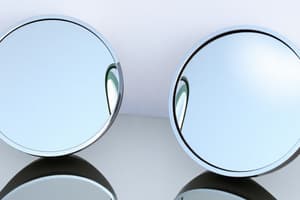Podcast
Questions and Answers
How is the focal length denoted in the mirror formula?
How is the focal length denoted in the mirror formula?
- `1/f = 1/u + 1/v` (correct)
- `1/u + 1/v = f`
- `u/v`
- `f = u + v`
What does a positive focal length indicate in mirror systems?
What does a positive focal length indicate in mirror systems?
- The mirror creates virtual images only
- The focal point is ahead of the mirror's vertex
- Light rays entering the mirror do not converge
- The focal point lies beyond the mirror's vertex (correct)
What type of mirror has a negative focal length?
What type of mirror has a negative focal length?
- Plane mirror
- Spherical mirror
- Convex mirror (correct)
- Concave mirror
What happens to light rays entering a concave mirror parallel to the principal axis?
What happens to light rays entering a concave mirror parallel to the principal axis?
If the focal length of a mirror is unknown, how can one calculate it using the mirror formula?
If the focal length of a mirror is unknown, how can one calculate it using the mirror formula?
Flashcards are hidden until you start studying
Study Notes
Mirror Formula and Focal Length
Overview
The mirror formula provides a relationship between different parameters of a mirror system, including the focal length, distance of the object from the mirror, and the distance of the image from the mirror. Understanding the mirror formula and its components, particularly the focal length, is crucial for visualizing how light behaves in different types of mirrors and predicting the resulting images.
Mirror Formula
The mirror formula, also known as the mirror equation, relates the focal length f, the distance of the object from the mirror u, and the distance of the image from the mirror v:
1/f = 1/u + 1/v
Focal Length
The focal length f is a critical parameter in mirror systems, representing the distance between the mirror's vertex and the focal point. The focal point is where light rays converge after being reflected off the mirror's surface. The focal length is positive for concave mirrors and negative for convex mirrors.
Concave Mirrors
In a concave mirror, the focal length is positive, meaning that the focal point lies beyond the mirror's vertex. As a result, light rays entering the mirror parallel to the principal axis converge at the focal point. This property allows concave mirrors to form real, inverted images of distant objects.
Convex Mirrors
In a convex mirror, the focal length is negative, indicating that the focal point is ahead of the mirror's vertex. Consequently, light rays entering the mirror parallel to the principal axis diverge away from the focal point. This characteristic leads to the formation of virtual, upright images of nearby objects.
Understanding the mirror formula and the focal length is advantageous for analyzing mirror systems, predicting image formation, and applying this knowledge in various scientific fields and everyday scenarios involving optics.
Studying That Suits You
Use AI to generate personalized quizzes and flashcards to suit your learning preferences.




